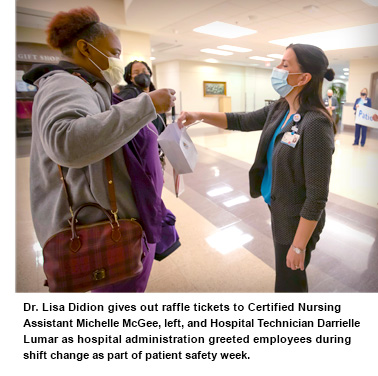Safety and quality: our patients deserve it
Good morning!
First off today, I’m happy to report that we wrapped up our 10-year accreditation process with the Southern Association of Colleges and Schools Commission on Colleges this week and the verbal report (pending final approval in December) came back as “No recommendations.” In accreditation speak, that is a gold star and the best possible outcome. Great news!
Lots of people are involved in this process but I want to specifically call out Ralph Didlake, associate vice chancellor for academic affairs, and Mitzi Norris, executive director for academic effectiveness, for their leading roles on this.
Now, on to today’s topic.
 It’s the final day of Patient Safety Week, an annual celebration of all that you do – both clinical and non-clinical employees – to keep our patients out of harm’s way. That means being diligent and purposeful in following our protocols and practices that protect patients from harmful events such as falls and infections.
It’s the final day of Patient Safety Week, an annual celebration of all that you do – both clinical and non-clinical employees – to keep our patients out of harm’s way. That means being diligent and purposeful in following our protocols and practices that protect patients from harmful events such as falls and infections.
What’s true, though, is every week at UMMC is Patient Safety Week. The 52 weeks of the year are mile markers on a journey, one we’ve traveled for the past seven years under the leadership of Chief Medical Officer Dr. Michael Henderson and his clinical quality and performance team. It’s our institution’s top strategic priority.
Quality and safety, and how they bring about improvements in our publicly reported patient care metrics, are not just the responsibility of a bedside nurse, a surgeon, a respiratory therapist, a pharmacist or any of our providers. It’s EVERYONE’S responsibility as we continue to build a culture of safety and address our clinical quality measures.
What we are doing, and the commitment we are making to quality and safety, even in a pandemic, is working! Here are few examples, seen through “scorecard” data collected since 2016:
- Hand hygiene compliance is up 64 percent. That means more employees are washing their hands before and after contact with patients, and before and after walking into a patient room on a hospital floor or a clinic exam room. Our mantra there: Hand hygiene every time, all the time.
- Hospital acquired infections have improved by 60 percent. This includes the difficult-to-treat infections MRSA (methicillin-resistant staphylococcus aureus), CLABSI (central line bloodstream infection) and CAUTI (catheter-associated urinary tract infection).
- Patient readmissions within 30 days of discharge is 17 percent lower.
- Patients having a good experience in our care has improved by 40 percent.
- Patient safety indicators – things that include how many patients develop complications from treatment – show a 33 percent improvement.
Our safety efforts also extend to our workforce and learners. UMMC’s Institutional Workplace Violence Committee is engaged in multiple efforts to stem violence and threats against providers and support staff and to support employees when events occur. Our Disruptive Behavior Policy covers threatening actions and words.
We have instituted RISE (Resilience in Stressful Events) to help employees who are stressed, whether it’s from the pandemic, from a bad outcome with a patient, or from a traumatic work event, including violence involving employees, patients or visitors.
Are we where we want or need to be on our safety and quality journey? Absolutely not.
Have we made progress toward a culture of safety? Yes, and the proof is in our data.
The Medical Center has progressively improved in the hospital safety grade compiled several times a year by the Leapfrog Group, based on data we voluntarily provide to the Centers for Medicare and Medicaid Services’ Hospital Compare quality reporting. For the past three years, our grade has been a C. We’ve made good progress over the years to get to that score, but like most of you would be, we aren’t satisfied with a C grade. But looking at the scores and grades of other academic medical centers and safety net hospitals like us in the region, we compare favorably. It’s based on patients admitted to UMMC, which has Mississippi’s only Level I trauma center and the state’s most advanced intensive care units, and which treats high-acuity patients transferred from other hospitals who must have a higher level of care.
That data historically isn’t adjusted to reflect the unique role academic medical centers play, or the types of patient populations they serve. AMCs and safety net hospitals like UMMC typically score lower than hospitals that don’t offer the highest levels of specialized patient care, in part because we typically care for the sickest, most vulnerable Mississippians, our greatest privilege We gladly accept our role in providing the most advanced care offered in our state, and other hospitals recognize our unique services by transferring their patients who need specialized care.
However ... In October 2015, UMMC’s Leapfrog Grade was an F. We’re transparent. We don’t hide that. Our latest score was a C, or 2.7125, up 68 percent from 2015. A grade of B, at 3.0, is so close and within reach.
Our journey continues. We walk together. We are “Chasing Zero,” The Joint Commission’s initiative adopted by the Medical Center in 2018 to eliminate serious safety events and to cultivate safer, more effective care. It’s a proactive approach to achieving zero patient harm – thus, chasing zero.
At the end of the day, it’s all about doing what benefits our patients. Safety is the cornerstone of quality. That’s how we roll as we chase not just zero, but A Healthier Mississippi.



